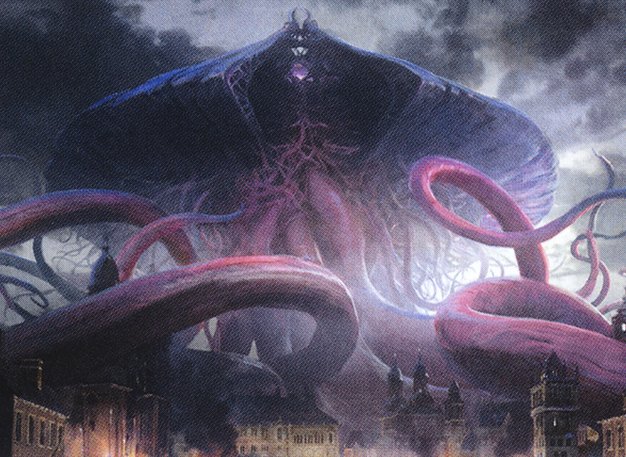 Art by Jaime Jones
Art by Jaime JonesIä,Iä, fellow cultists,
This is my first EDH/commander cube! As you can see I'm a really passionate lovecraftian/old school horror fan so I decided to start slowly building my horror theme cube with all kind of monstrosities! Iä, Iä! But of course you need the holy side fight against these lurking madnesses!
What I have:
-
Theme/idea for cube is horror based (basically Innistrad flavor). Humanity vs Cosmic Horror and other spookies!
-
Designed for one-on-one and four player multiplayer games.
-
Try to optimize the size between 720-800 cards, working process...
-
Power level seems to be 6-8. No 2cmc or under mana rocks like Sol Ring (except talismans), no broken removal as Mana Drain and no crazy combos. There is few cards that seems really powerful to others like Time Warp etc. but these gives powerful flavor when you exercise forbidden rituals and open portals for Emrakul, the Promised End! Iä, Iä!
EDH/Commander rules:
The Commander format is all about picking your hero or villain and building a deck around them. In this casual, multiplayer format, you choose a legendary creature to serve as your commander and build the rest of your deck around their color identity and unique abilities. Players are only allowed one of each card in their deck, with the exception of basic lands, but they can use cards from throughout Magic's history.
COLOR IDENTITY
A card's color identity can come from any part of that card, including its casting cost and any mana symbols in its text. Every card in your Commander deck must only use mana symbols that also appear on your commander. Colorless cards are allowed as well.
COMMAND ZONE
This is where your commander resides during the game when they are not in play. At the start of the game, each player puts their commander face up into the command zone. A commander can be cast from the command zone for its normal costs, plus an additional two mana for each previous time it's been cast from the command zone this game. If your commander would be put into your library, hand, graveyard or exile from anywhere, you may return it to your command zone instead.
COMMANDER DAMAGE
A player that's been dealt 21 or more combat damage by the same commander over the course of the game loses the game. The commander is tracked across zone changes for this purpose (for example, if one player takes control of another player's commander, any damage that commander already dealt is still counted).
Drafting Rules:
-
You will be drafting a 60 card deck using three packs of 21 cards.
-
All mono color legendary creatures has 'Partner' ability. (Partner is an ability that modifies the rules for deck construction in the Commander variant, and it functions before the game begins. Rather than a single legendary creature card, you may designate two legendary creature cards as your commander if each has partner.) 'Friends Forever' and 'Partner with' abilities are replaced 'Partner' ability in this cube.
-
Nephilim creatures can be your commander.
-
Any planeswalker can be your commander.
-
Hybrid mana cards count as an “or” when played in your deck. (So a card that has a
 hybrid mana cost, and no activated abilities, can be treated as either a white card or a red card.) As your commander, hybrid mana cards are treated as “and” cards. (So a w/r hybrid legendary, as your commander, would have two color identities.)
hybrid mana cost, and no activated abilities, can be treated as either a white card or a red card.) As your commander, hybrid mana cards are treated as “and” cards. (So a w/r hybrid legendary, as your commander, would have two color identities.) -
Friendly mulligan. Your first draw is to 7, second draw is to 7, third is to 6, fourth is to 6, etc. If you start with fewer than 7 cards, you get to scry 1. In multiplayer games, starting player draws a card. In single player games, staring player skips their first draw step.
-
Players start with 40 life in multiplayer games and 25 life in one-on-one games. This reduced life in one-on-one allows aggressive decks to compete. Single player games are Best of One.
Specific Rules:
-
After draft every one can add Command Tower in their deck to help fixing your manabase. There is none in the cube.
-
Day/Night mechanic is in the game immediately and the game starts from the day. Old werewolves use day/night mechanic if it is not activate ability, examble Conduit of Storms. Other transformations in non-werewolf cards works normally.
These are main archtypes in this cube:
Tribals:
-
Humans. Works best as a team! If there is nothing else, there are a lot of humans in all colors. They can play a main role or minor role in different strategies.
- Strongest color pair is White/Green. Also Black works well.
-
Vampires. These bloodsuckers are best in gaining life and using it againts your opponents. Look after 'blood token' producers.
- Strongest colors Red/Black. You can also find decent vampires in White.
-
Werewolves. These moon howlers needs more make them work, but oh when they work, prepare yourself some serious ass kicking! Beware the Night!
- Main colors in Red/Green.
-
Horrors. These abominations are ready to drive you crazy or well at least eat your deck, you know what that means, a unpleasant journey into time and space!
- Strongest colors Black/Blue.
-
Spirits. These spooky ghosts seems harmless but they have mind tricks in their... sleeves? At least they fly over you and suck your soul with them!
- Strongest colors White/Blue.
Colors:

- Holy side.
- Lots of humans helped by some angels. Also connection to spiritual world.
- Healing powers. (Lifegain)
- Rituals for holiness and sometimes for evil. (Sacrificing)

- The root of all evil. Supporting vampires and horrors.
- Sacrificial rites.
- Reanimation.

- Uncanny and mind flayers. Supporting spirits and horrors.
- Controlling your moves.
- Copycat.
- Eating your deck. (Mill)

- Growing big and wide. Supporting humans and werewolves.
- Regrowth.
- Harmony with all living and death. (Landfall)
- Fiery counter attack. Supporting vampires, werewolves.
- Keep coming.
- Hitting hard. (Combat tricks)

- Spirits.
- Blink/Flicker. (archetype that temporarily exiles its own permanents and brings them back into play for the purposes of re-triggering their enters-the-battlefield abilities.)
- Aristocrats. (archetype that seeks to sacrifice its own creatures, especially many low-cost and/or token creatures, to accumulate game-winning benefits. Aristocrats decks use a combination of sacrifice outlets and cards that trigger when their creatures enter and/or leave the battlefield.)
- Minor Lifegain. (archetype in which a player increases their own life total, often with the goal of turning their own large life total into a resource that can be wielded to defeat their opponents.)
- Mill. (archetype that seeks to defeat opponents by eliminating the cards in their libraries, rather than by reducing life totals to 0. It does this by ‘milling’ cards (putting the top cards of a library into its owner’s graveyard). Then, when opponents attempt to draw a card from an empty library, that player loses the game.)
- Theft. (This theme is based on card that gain control of other cards.)
- +1/+1 counters. (+1/+1 counters are a mechanic in Magic that have enough cards that synergize with each other to be used an an Archetype. Each counter increases both the power and toughness of a creature they are on, and therefore in enough numbers can turn any creature into a major threat.)
- Reanimator. (Reanimator is a deck archetype known for putting powerful creature cards into their graveyard, then using spells or abilities to return those creatures to the battlefield for a cheaper cost.)
- Self-Mill. (Self-mill is a strategy that focuses on placing as much of one’s own library into the graveyard as quickly as possible, most commonly for the purposes of using cards in that graveyard for additional resources, recursion, and/or reanimation. This is contrasted to the mill archetype, which puts cards from opponents' libraries into the graveyard, though both archetypes may use similar cards to achieve these goals.)
- Werewolves.
- Minor landfall. (Landfall (or 'lands') is a deck archetype that gains benefit from putting land cards onto the battlefield or for having lots of lands on the battlefield.)
- Humans.
- Tokens. (Token decks focus on creating a large number of token creatures to overwhelm their opponents. Token strategies often take the form of aggro decks, using a high density of creatures, commonly paired with effects that increase their power, to defeat enemies with combat damage.)
- Vampires.
- Sacrifice. (This theme is based on cards that sacrifice permanents or trigger on sacrifice.)
- Aggro/Tokens.
- Extra combat. (This theme is based on cards that grant extra combat phases.)
- Spellslinger. (is an umbrella term for decks that focus primarily on instant and sorceries. They often contain a mix of low-cost spells that may be cast in quick succession as well as high-cost, powerful spells that many other archetypes may find difficult to cast. Spellslinger decks often contain similarities to Storm, Control, and Combo strategies, though they are not a prerequisite for the Spellslinger archetype.)Yes, there are plenty of cards but there are a lot of synergies which should carry you through the draft and helps you to build a decent deck.
- Kozilek, Butcher of Truth
- Ulamog, the Infinite Gyre
- Elbrus, the Binding Blade
- Eldrazi Conscription
- Morophon, the Boundless
- Heartless Summoning
- Shark Typhoon
- Wedding Announcement
- Smothering Tithe
- Archaeomancer's Map
- Wedding Ring
- Akroma's Will
- Bribery
- Time Warp
- Mystical Tutor
- Cryptic Command
- Sakashima of a Thousand Faces
- Professor Onyx
- Tevesh Szat, Doom of Fools
